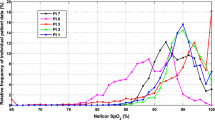Abstract
Large data sets from electronic health records (EHR) have been used in journal articles to demonstrate race-based imprecision in pulse oximetry (SpO2) measurements. These articles do not appear to recognize the impact of the variability of the SpO2 values with respect to time (“deviation time”). This manuscript seeks to demonstrate that due to this variability, EHR data should not be used to quantify SpO2 error. Using the MIMIC-IV Waveform dataset, SpO2 values are sampled from 198 patients admitted to an intensive care unit and used as reference samples. The error derived from the EHR data is simulated using a set of deviation times. The laboratory oxygen saturation measurements are also simulated such that the performance of three simulated pulse oximeter devices will produce an average root mean squared (ARMS) error of 2%. An analysis is then undertaken to reproduce a medical device submission to a regulatory body by quantifying the mean error, the standard deviation of the error, and the ARMS error. Bland-Altman plots were also generated with their Limits of Agreements. Each analysis was repeated to evaluate whether the measurement errors were affected by increasing the deviation time. All error values increased linearly with respect to the logarithm of the time deviation. At 10 min, the ARMS error increased from a baseline of 2% to over 4%. EHR data cannot be reliably used to quantify SpO2 error. Caution should be used in interpreting prior manuscripts that rely on EHR data.




Similar content being viewed by others

Data availability
The MIMIC-IV waveform dataset is presently available online.
The source code used to compile and process the data is available online:
References
Bickler PE, Feiner JR, Severinghaus JW. Effects of skin pigmentation on pulse oximeter accuracy at low saturation. Anesthesiology. 2005;102:715–9. https://doi.org/10.1097/00000542-200504000-00004.
Barker SJ, Wilson WC. Racial effects on Masimo pulse oximetry: a laboratory study. J Clin Monit Comput. 2022. https://doi.org/10.1007/s10877-022-00927-w.
Fawzy A, Wu TD, Wang K, Robinson ML, Farha J, Bradke A, Golden SH, Xu Y, Garibaldi BT. Racial and ethnic discrepancy in pulse oximetry and delayed identification of treatment eligibility among patients with COVID-19. JAMA Intern Med. 2022;182:730–8. https://doi.org/10.1001/jamainternmed.2022.1906.
Sjoding MW, Dickson RP, Iwashyna TJ, Gay SE, Valley TS. Racial Bias in Pulse Oximetry Measurement. N Engl J Med. 2020;383:2477–8. https://doi.org/10.1056/NEJMc2029240.
Valbuena VSM, Seelye S, Sjoding MW, Valley TS, Dickson RP, Gay SE, Claar D, Prescott HC, Iwashyna TJ. Racial bias and reproducibility in pulse oximetry among medical and surgical inpatients in general care in the Veterans Health Administration 2013-19: multicenter, retrospective cohort study. BMJ. 2022;378:e069775. https://doi.org/10.1136/bmj-2021-069775.
Al-Halawani R, Charlton PH, Qassem M, Kyriacou PA. A review of the effect of skin pigmentation on pulse oximeter accuracy. Physiol Meas. 2023. https://doi.org/10.1088/1361-6579/acd51a.
Shi C, Goodall M, Dumville J, Hill J, Norman G, Hamer O, Clegg A, Watkins CL, Georgiou G, Hodkinson A, Lightbody CE, Dark P, Cullum N. The accuracy of pulse oximetry in measuring oxygen saturation by levels of skin pigmentation: a systematic review and meta-analysis. BMC Med. 2022;20:267. https://doi.org/10.1186/s12916-022-02452-8.
Sarraf E, Mathews DM, Tsai MH, Goodwin AJ. Optimizing the use of point of care testing devices for screening patients. J Clin Monit Comput. 2020;34:411–9. https://doi.org/10.1007/s10877-019-00332-w.
Rezek IA, Roberts SJ. Stochastic complexity measures for physiological signal analysis. IEEE Trans Biomed Eng. 1998;45:1186–91. https://doi.org/10.1109/10.709563.
Clarke M, Gokalp H, Fursse J, Jones RW. Dynamic threshold analysis of Daily Oxygen Saturation for Improved Management of COPD patients. IEEE J Biomed Health Inform. 2016;20:1352–60. https://doi.org/10.1109/jbhi.2015.2464275.
Moody B, Hao S, Gow B, Pollard T, Zong W, Mark R. (2022) MIMIC-IV Waveform Database (version 0.1.0) https://doi.org/10.13026/a2mw-f949.
Goldberger A, Amaral L, Glass L, Hausdorff J, Ivanov P, Mark R, Mietus J, Moody G, Peng C, Stanley H. PhysioBank, PhysioToolkit, and PhysioNet: components of a new research resource for complex physiologic signals. Circulation [Online]. 2000;101:e215–20. https://doi.org/10.1161/01.cir.101.23.e215.
(2013) Pulse Oximeters - Premarket Notification Submissions [510(k)s]: Guidance for Industry and Food and Drug Administration Staff.FDA-2007-D-0205. https://www.fda.gov/media/72470/download.
Gehring H, Duembgen L, Peterlein M, Hagelberg S, Dibbelt L. Hemoximetry as the gold standard? Error assessment based on differences among identical blood gas analyzer devices of five manufacturers. Anesth Analg. 2007;105:24–s30. https://doi.org/10.1213/01.ane.0000268713.58174.cc.
Bland JM, Altman DG. Agreement between methods of measurement with multiple observations per individual. J Biopharm Stat. 2007;17:571–82. https://doi.org/10.1080/10543400701329422.
Goodwin AJ, Eytan D, Dixon W, Goodfellow SD, Doherty Z, Greer RW, McEwan A, Tracy M, Laussen PC, Assadi A, Mazwi M. Timing errors and temporal uncertainty in clinical databases-A narrative review. Front Digit Health. 2022;4:932599. https://doi.org/10.3389/fdgth.2022.932599.
Weisstein EW. (2023) Expectation Value. MathWorld–A Wolfram Web Resource https://mathworld.wolfram.com/ExpectationValue.html. Aug 22 2023.
Acknowledgements
The author would like to thank Ms. Emily Raffensberger for her assistance in proofreading the manuscript.
Funding
This work was supported by departmental funds.
Author information
Authors and Affiliations
Contributions
ES was the sole participant in the study conception, design, analysis and drafting of the manuscript.
Corresponding author
Ethics declarations
Competing interests
Elie Sarraf was an employee of Masimo Corp from July 2013 to January 2015.
Ethical approval
Not applicable (data publicly available).
Informed consent
Not applicable.
Additional information
Publisher’s Note
Springer Nature remains neutral with regard to jurisdictional claims in published maps and institutional affiliations.
Supplementary Information
Below is the link to the electronic supplementary material.
Rights and permissions
Springer Nature or its licensor (e.g. a society or other partner) holds exclusive rights to this article under a publishing agreement with the author(s) or other rightsholder(s); author self-archiving of the accepted manuscript version of this article is solely governed by the terms of such publishing agreement and applicable law.
About this article
Cite this article
Sarraf, E. Electronic health record data is unable to effectively characterize measurement error from pulse oximetry: a simulation study. J Clin Monit Comput (2024). https://doi.org/10.1007/s10877-024-01131-8
Received:
Accepted:
Published:
DOI: https://doi.org/10.1007/s10877-024-01131-8



